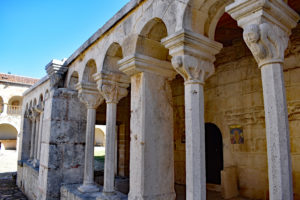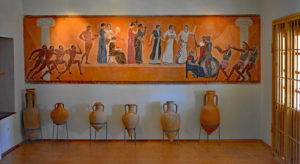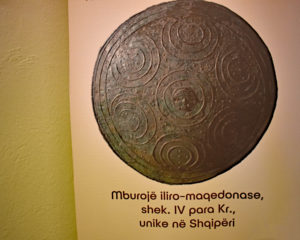Whilst staying in “Vlora”:https://www.silvertraveladvisor.com/review/attraction/201465, on Albania’s southwest coast, we took a day trip to the ancient city of Apollonia. Founded in 588, it was named after the Greek god, Apollo. The city continued to thrive in Roman times as one of the starting points of Via Egnatia, one of the great arterial roads of the era. This importance grew with trade and as a military port, but natural disasters including earthquakes, shifted the river that created the port and left the city stranded high on a hill. It then fell into decline.
The entrance fee was 400 Lek/£2.90 each and we were fortunate that our guide Ari, an archaeologist, had worked on the site for 11 years. A French team led by Leon Rey started excavations in 1924. It was chosen as the French wished to establish links with Albania and having analysed where they could best make a mark, dismissed Durres as too popular and saw this untouched site. In addition, it had been the place where Octavia, son of Augustus, had studied and was therefore of interest. This is a huge site and it was amazing to think that less than 10% of the site has been excavated.
At a map of the site, in French, Albanian and English, Ari pointed out the gridded, quadratic system of streets. He explained that when communities developed and areas of like-minded people wanted to come together, they used a church as the focus and so they would fund it.
Ari led us around the key features of the extensive site, where computer generated images helped us to see what the various areas might have looked like:
The Bouleuterion, where the city council met, was the site’s most stunning feature, although it had been heavily reconstructed in the 1970s. Each year, 12 Mayors would have been elected (i.e. one for each month), which diluted any single attempt to gain power.
The Odeon, a small theatre for the great and the good, only seated around 300 people. Later on, we also saw the remains of the public theatre, which had crumbled far down a slope and much of the stone had been recycled over years.
Moving on, we strolled along a two-storied portico, known as Stoa B, where people would have met to socialise. On one side was a wall, built with large stones to prevent a landslide from the hill behind, with a line in the stones that allowed movement to be detected. The wall was punctuated by 17 semi-circular niches which would have contained marble statues (we saw some of these later).
As the city did not have an aqueduct, a cistern was used which had been turned into three shops. The bricks for the water storage area were small and would have been made waterproof using eggshells and goat wool.
The Acropolis, always the highest point of a city, was now simply a grass covered mound as the communists had ruined it in the 1970s by digging tunnels underneath it for Chinese gun emplacements.
In the church, many of the frescoes were said to be Italian in influence rather than Byzantine, but photographs were not allowed. Here we saw some of the recycled stones including one with upside down animals. Ari said this was possibly because the stone mason thought that one edge was better for the corner and as this was his job, he put it in the best way round for the corner not the aesthetics. The portico of the church had unusual gargoyles on the pillars.
We walked along a portico with the incredibly preserved statues found in the arches of Stoa B. Many were headless, and Ari said that the bodies would have been used and new heads added where necessary e.g. if a man remarried.
Finally, we visited the extensive museum where after a brief introduction to its layout i.e. all local artefacts, in chronological order, we wandered through the displays of jewellery, needles and ornaments, amphora or vessels for transporting goods, statues and busts. We remarked on the excellent condition and were told that many had been found in graves and were untouched or had been well restored. A bronze 4th century shield had been found in 8,051 pieces and restored over 27 years by a gentleman said to be ‘married to the shield’ as at the age of 74, he’d failed to find a wife. Also, in the museum was a headstone to a couple which suggested they had been married for 42 years without quarrelling: we all agreed this was an impossible feat.










